#and lends to a more balanced story within the worldbuilding
Explore tagged Tumblr posts
Text
Including any spinoffs and games. Check this blog for the companion poll for cis people.
–
We ask your questions so you don’t have to! Submit your questions to have them posted anonymously as polls.
#to anwser my own poll#I've wrote eleven unpublished chapters of fixit fic right as rowling was starting down the dark path#because I didn't like how the story she told was biased toward the griffindor perspective on things#by moving the four main characters into different house it fixes the biasing issue#and lends to a more balanced story within the worldbuilding#I loved the idea of harry potter#the potential in the mythos#and hated how the author had squandered it#and then I started hating the author for being a transphobic scumbag
1K notes
·
View notes
Photo





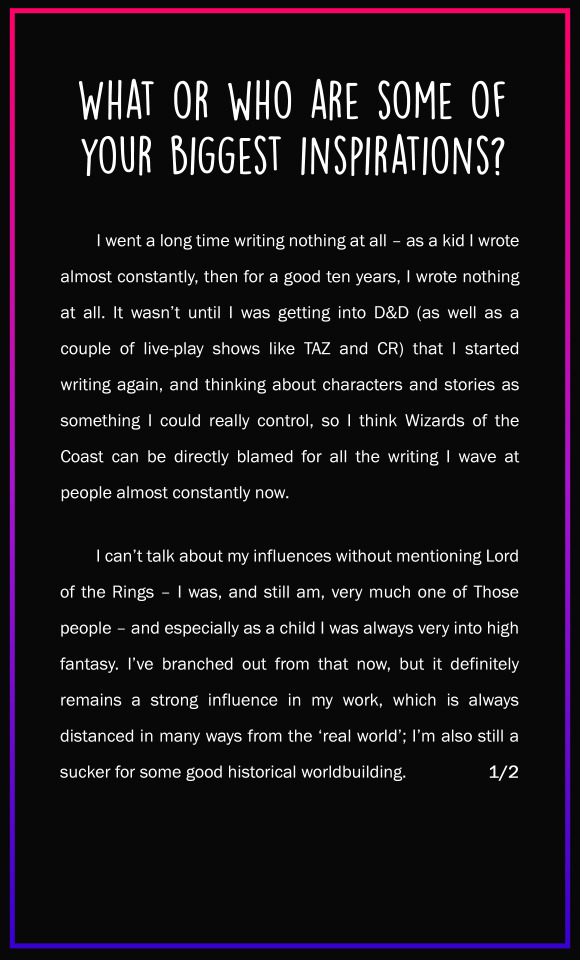
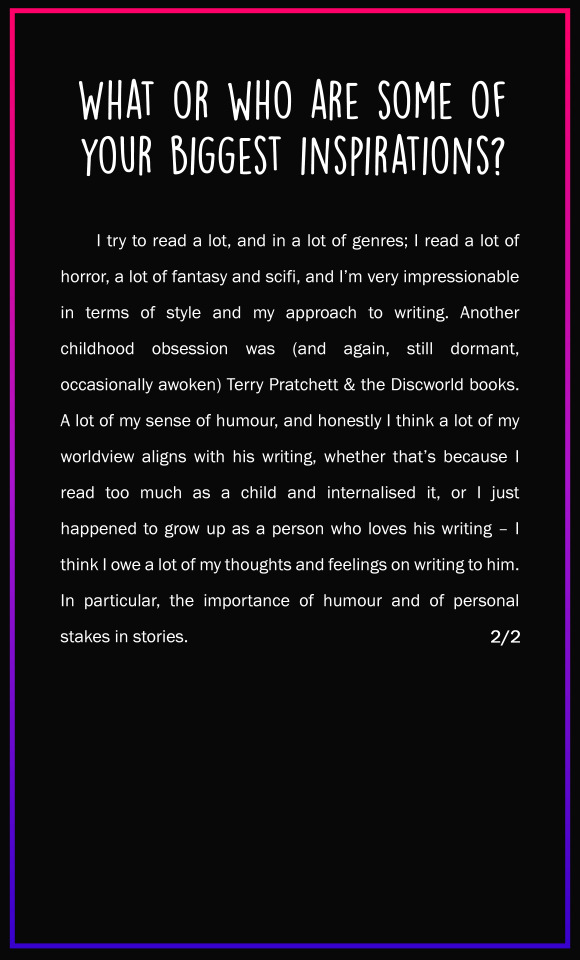


Day 6 of Pride Month interviews! Up next we’ve got the wonderful Nyehilism!
Nyehilism, author of Sentinel
Pride Month Featured Author
You’re frozen, unable to move as you meet bloodshot eyes.
You can’t breathe, can’t think. There’s an awful familiarity, and for just a moment, you feel like you’re looking in a mirror, your warped reflection snarling back at you.
Then there’s a crack, loud enough to break the spell, and the monster s c r e a m s.
A brutal murder rocks the balance of your life. An old friend is lying to you, and a stranger knows more than he’s telling. You dream of people and places you’ve never seen, of flowers and buildings and vast strange skies - and during the day, you’re hunted by a creature like nothing you’ve seen before. We all have demons, but you hadn’t expected yours to follow you through death.
Your past has caught up with you, and it has teeth.
Demo: Sentinel, Project Hadea
Tags for Sentinel: urban fantasy, horror
Tags for Project Hadea: sci-fi, +18
(INTERVIEW TRANSCRIPT UNDER THE CUT!)
Q1: Tell us a little bit about your project(s)!
Sentinel is an exploration into the idea of reincarnation & past lives – persistent consciousness is a big point of interest for me, and the idea of exploring past identities and decisions, and how those affect apparently unrelated events is something I love seeing explored in other fiction.
Project Hadea is more of an exploration of ability and self-worth – what happens when the foundation you’ve built your life on is lost? If this all makes me sound pretentious, it’s probably because I am. To be honest, as a relatively new project, I’m still waiting for the themes of Hadea to come through, but I’m looking forward to them presenting themselves to me.
Beyond that, both projects are excuses for me to mess with worldbuilding and character interactions, as well as dipping into different styles and genres.
Q2: Why interactive fiction? What drew you to the medium?
Like a lot of other IF authors, I’m a huge fan of interactive storytelling – things like D&D, Pathfinder, etc – and as a character-driven writer, I really enjoy the challenge that comes with what is, essentially, telling multiple stories in one, where a single character can drastically alter the direction of the plot. That, in combination with the inclusivity within these types of media – where the customizability of characters inherently lends itself to the creation of non-standard protagonists – really caught my attention.
Q3: Are your characters influenced by your identity? How?
My characters are almost entirely bisexual, and the ones that aren’t are some flavour of LGBT+. I don’t know how much more I can say, honestly: I’m so far gone at this point I tend to forget it’s possible to create heterosexual characters. I think in more general terms, a lot of my characters tend to take very... pragmatic? Approaches to gender and sexuality, as influenced by my own experience: I’ve always known I’m not straight, and while it’s an inherent part of my identity, I don’t think about it much.
Q4: What would you like to see more of in LGBT+ fiction?
Honestly, any and everything. More wlw, more nblw/m, more interracial non-cishet relationships, more open acknowledgement of character’s sexuality. In particular, I’d like to see more bisexual characters who are openly bisexual, without using cutsey little phrases to dance around the word. Bisexual characters in both different- and same-gender relationships, where their bisexuality is still knowledged and accepted.
Also, more non-binary characters, characters exploring and changing their identities throughout the course of the story and it not being a big deal.
Q5: What or who are some of your biggest inspirations?
I went a long time writing nothing at all – as a kid I wrote almost constantly, then for a good ten years, I wrote nothing at all. It wasn’t until I was getting into D&D (as well as a couple of live-play shows like TAZ and CR) that I started writing again, and thinking about characters and stories as something I could really control, so I think Wizards of the Coast can be directly blamed for all the writing I wave at people almost constantly now.
I can’t talk about my influences without mentioning Lord of the Rings – I was, and still am, very much one of Those people – and especially as a child I was always very into high fantasy. I’ve branched out from that now, but it definitely remains a strong influence in my work, which is always distanced in many ways from the ‘real world’; I’m also still a sucker for some good historical worldbuilding.
I try to read a lot, and in a lot of genres; I read a lot of horror, a lot of fantasy and sci-fi, and I’m very impressionable in terms of style and my approach to writing. Another childhood obsession was (and again, still dormant, occasionally awoken) Terry Pratchett & the Discworld books. A lot of my sense of humour, and honestly I think a lot of my worldview aligns with his writing, whether that’s because I read too much as a child and internalised it, or I just happened to grow up as a person who loves his writing – I think I owe a lot of my thoughts and feelings on writing to him. In particular, the importance of humour and of personal stakes in stories.
Q6: What’s a super vague spoiler for your current project?
Be careful what you wish for.
Q7: Lastly, what advice would you give to your readers?
Nothing stays the same: life won’t go the way you expect, but that’s not a bad thing. Go for the moments when you see them – whether its job or education applications, starting new projects, learning new skills – just go for it. You can get away with more than you’d think, especially if you do it with confidence.
#if: events#Pride Month 2021#pride month#queer authors#queer creators#queer fiction#interactive fiction
93 notes
·
View notes
Link
‘I do believe in fairies! l do! I do!’
Peter Pan - J.M. Barrie
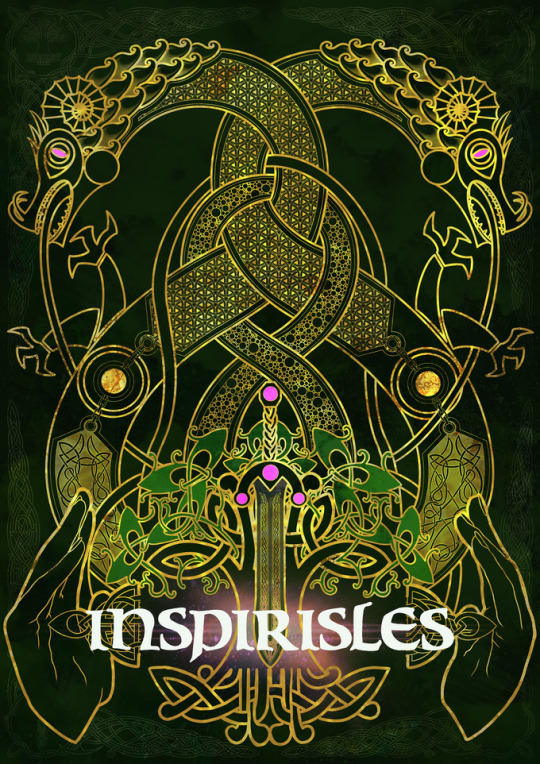
Experiencing visions of a mythical land throughout your childhood, you are suddenly transported to the Inspirisles, a kingdom ruled by the fey. Responsible for a pact made long ago by your ancestors, you must now earn Belief and the respect of their gods or find yourself trapped there forever.
INSPIRISLES is a completely original tabletop RPG aimed at teenagers. It will promote empathy, life skills and deaf awareness with an emphasis on teamwork and creativity.
Play as teens gifted extraordinary powers.
Meet famous characters and fearsome monsters from Celtic folklore.
Work together to heal a crumbling land and restore a fractured kingdom.
Learn British/American Sign Language as you cast spells and solve puzzles.
Become apprentices to the gods.
Offer Belief to earn your tickets home.
This project came about after running my teen Dungeons & Dragons group Hatchlings for over a year. I wanted to create something for them. Something they could have a hand in building. And something I could take beyond the group to use in schools and communities as a workshop model. Inspirisles is the result of this, a game for young players that reflects my interest in folklore and my ongoing work with the deaf community.
Though Inspirisles is aimed at children, it can be enjoyed equally by adults and we are especially encouraging parents, educators and tabletop beginners to invest in our game. Many of us have fond memories of 80s fantasy classics such as The NeverEnding Story & Labyrinth. Inspirisles aims to capture some of that nostalgic magic and transport its older participants back to a more carefree and imaginative time.


Standard & Limited Edition book mock-ups
A5 premium-colour hardback with over 150 pages of material, including...
History of the islands and their Friends.
Creating your Foundling character.
Collection of spell, ability & item cards and the tools to invent your own.
A host of worldbuilding ideas & mechanics to breathe life into your quests, including using the arts in roleplaying, creating challenging environmental puzzles, alternative ways to earn Belief, rules for Inspired apprenticeships, exploration, downtime & Doom.
Scriv’s Tour: Follow the famous bard as she journals the key locations & personalities you will encounter during your adventures.
Scriv’s Story: Fiction retelling the moment our bard met Athelyn for the first time (Limited Edition only).
Menagerie of monsters from Celtic folklore & the tools to invent your own.
Starter adventure: ‘Duster Trials’.
Stunning art from cover to cover, including maps for locations and encounters.
Two page spread of Josh Somerville’s spectacular knot art (Limited Edition only).
Dyslexia friendly fonts throughout to prioritise accessibility.
Handouts: Blank character sheet, Shaping alphabet (BSL & ASL), milestone certificates & Grail template.
* terms in bold explored below.
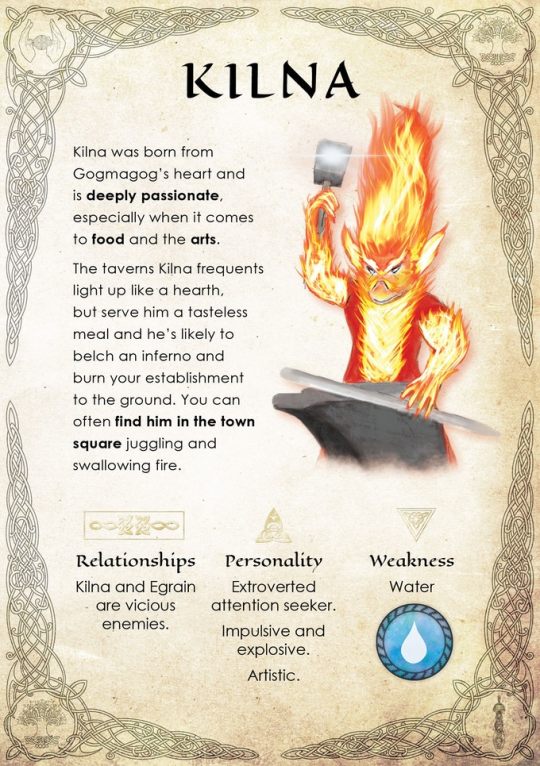
Page sample by Anna Urbanek of Double Proficiency

Belief is the keystone of the Inspirisles. The energy binding all things. In its absence, the land and its children would fade from life and from memory.
If Belief were to run dry, it would have terrible repercussions. Imagine something calamitous like Earth’s polar caps suddenly melting or electricity disappearing from the globe overnight.
Though Belief is generated through such things as exploration, the arts, work and even battle, these pale in comparison to the amount collected from human children.
As children believe in magic less and less, the inhabitants of the Inspirisles must come up with new and increasingly creative ways to convince them otherwise.
Belief gathered from Earth is taken to the World Tree and released over its roots. This energy then spreads throughout the land, healing the foundations of the islands.
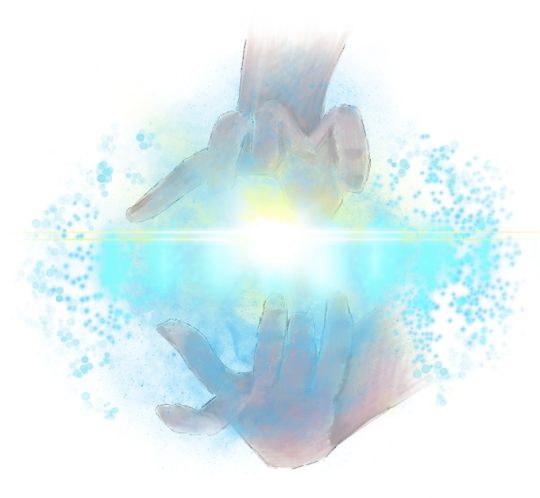
Shaping

A place where the gods walk freely, where dragons are hunted for hoarding Belief, where a war rages between Friends, where reforging an ancient sword can reforge a kingdom, where sign language is used to cast spells, where there is no death, only Disbelief, and where heroes rise and fall together.
It is also a setting to reflect the struggles of our own world. You’ll find environmental calamity, political greed and social injustice to name but a few. Making Inspirisles relatable to our future generations was an ambition from the very start. However, we would never want to push an agenda, so building a platform for whichever stories need to be told has been our sole responsibility.
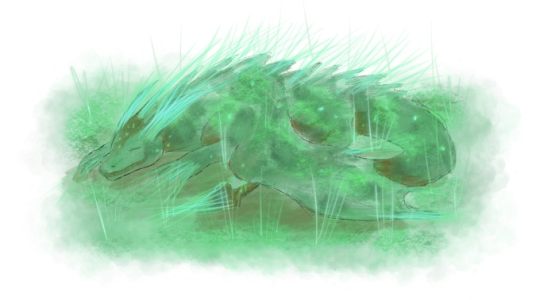
Hibernation

Our system and its mechanics are entirely built around the theme of Belief. Players must work together to collect this wondrous commodity, reaching the heights before deciding whether to stay and enjoy the renown or return home and reunite with their true families.
Moving away from systems found in many popular tabletop RPGs, Inspirisles is largely aimed at young adults and does away with traditional mechanics such as racial bonuses, class systems, ponderous combat and even death.
Though our players should expect an open, sandbox experience, it’s nice to have an overall goal in mind. As such, the concept of healing the land as a team for rewards and progression is at the heart of Inspirisles.
As with any roleplaying game, Inspirisles will throw challenges at its players. As well as social and environmental encounters, Foundlings (players) will inevitably come across familiar monsters of Celtic legend, such as the Questing Beast who will stalk them across the land. Within the book, you’ll also discover many nasties of our own invention and the tools to invent your own.

Don’t go it alone!


Attributes
Foundlings will have six attributes: sword, shield, speed, smarts, social & survival. When facing obstacles, they can lay down up to three cards representing spells, abilities or items. These cards display unique properties that will have an impact on their attribute bonus. Players then roll 2d6, adding the attribute bonus plus any additions from the cards. If the obstacle they are facing is truly perilous, they may turn to their Grail Pool as a last resort, a resource only carried by Foundlings.
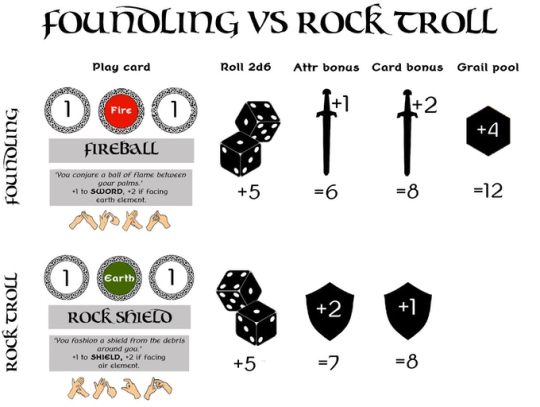
Sample obstacle resolution
Obstacles can include social interactions, puzzles, environmental challenges and battle. Whether the obstacle is resolved through roleplay or combat, if it requires a check, it is always contested between player and Grail Guide (Game Master).
With every failed encounter and instead of suffering injury or death, Foundlings will instead experience Disbelief. If too much Disbelief is accumulated as a group, players must pull together to reduce it using the Belief they may be saving for a rank or new cards. This balancing act encourages empathy between participants, but also prevents Doom from affecting the islands.
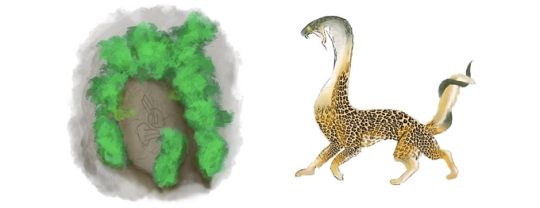
Puzzles & predators

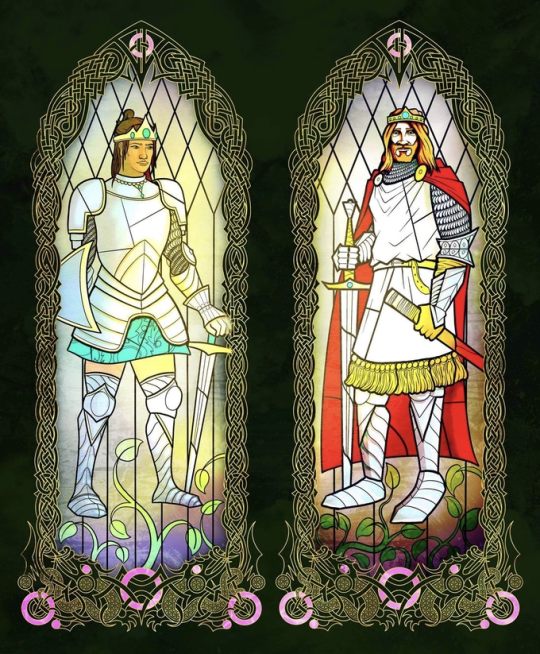
Guinevere & Arthur, our Grail Guide choices
Our version of a Game Master is called the Grail Guide (GG). A participating adult or teenager will take on the role of GG and become the spirit of King Arthur Pendragon or Queen Guinevere. It will be their task to guide the players on their journey, making decisions on the rules, lending voice to the citizens and fangs to the denizens, and encouraging everyone to work together, share the limelight and have fun.
As the GG, you also have the unique opportunity to gift your players their Grail Pool, a set of polyhedral dice (d4, d6, d8, d10, d12 & d20). Foundlings are the only beings able to carry this water poured from the Holy Grail. Even a sip will offer them an edge when facing the greatest of challenges and most dangerous of foes.
Talking of the Grail, with the book will be a template for the holy vessel that GG’s can cutout before sessions. This prop is then placed in the centre of the playing space and can be flipped whenever a player finds a theme or scenario too difficult. The GG can then move on swiftly without disrupting the overall session.
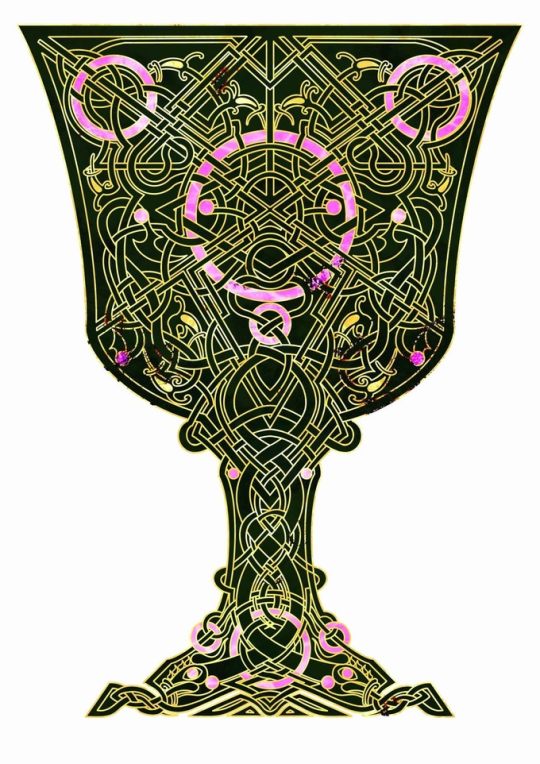
Safety tool
It is also the responsibility of the GG to add tension and peril to the experience. If their players accumulate too much Disbelief, they can consult a Doom chart. This will change the Inspirisles in dramatic ways, such as causing a volcano to erupt, introducing the Questing Beast to hunt Foundlings, having Excalibur seized by an enemy or building a troll bridge on the outskirts of a city.
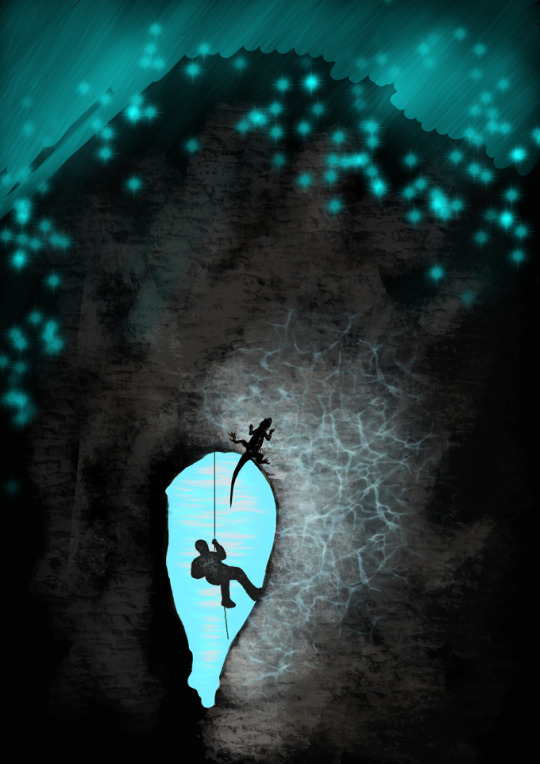
Spelunking

As a player, you take on the role of Foundling, a human teen drawn by fate to the islands. Instead of selecting a race or class, Foundlings are trained by one of eight fey clans, otherwise known as Friends. The Knockers, Glow, Wyrmbitten, Capra, Piskies, Giantheld and Bucca populate distinct locations from city to forest, tin mine to tundra. Seven of these races work tirelessly to restore Belief and prevent the collapse of the Inspirisles. Whilst the eighth, an exiled people known as Glimmers refuse to help, sheltered far beneath the surface where the cracks go unseen and the tremors unfelt.

Friends
As a Foundling, once Belief is gathered, it can be used in 3 distinct ways...
Pilgrimage to Avalon where the World Tree sits. Belief is offered to its roots in exchange for training.
Patronage to the Inspired. Belief is offered in exchange for spells.
Provide for the community they were embraced by. Belief is offered in exchange for items.
Regardless of how Foundlings offer Belief, they will earn the favour of the ruling houses and feel their reputation and power grow.
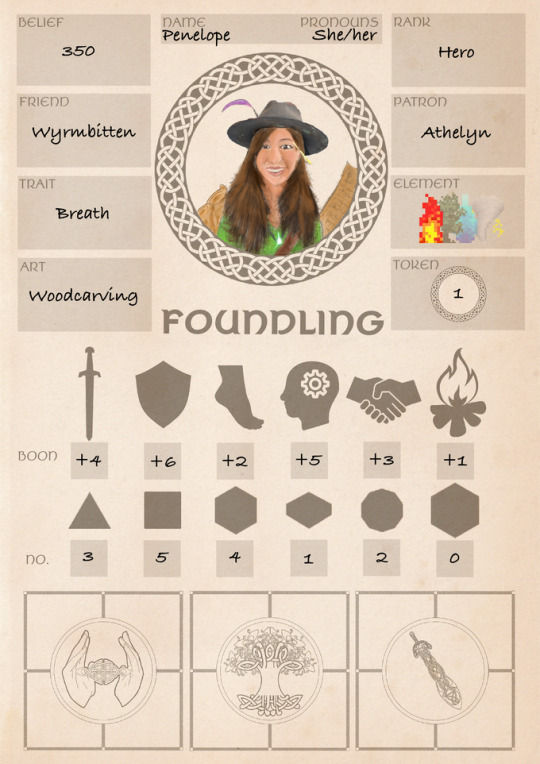
Foundling character sheet

The Inspired are the closest thing the islands have to deities. Their influence can be felt across the kingdom at all times and ultimately players will need to impress them if they are to return home.
As well as being great teachers of magic in the form of Shaping, they have trades in their homelands, allowing Foundling players to become apprentices and earn Belief through hard work and dedication.
Kilna of the Fire has his forge.
Egrain of the Earth has her vinyard.
Athelyn of the Water has their bath house.
Vorm of the Air has his skyship.
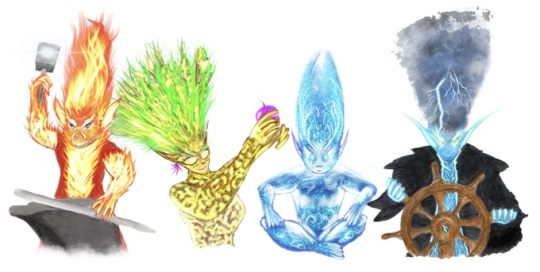
The Inspired

Travelling via All’s Well, a mysterious portal leading to the British Isles, on their 15th birthdays, the brightest and bravest Foundlings are sent Earthwards to collect Belief. These elite are known as Dusters.
With the help of a Wellwisher, a common mammal transformed by Athelyn to be more like you and I, Dusters will be guided to a child without Belief, a teenager struggling to feel magic in their life.
Players will then roll a six-sided Dusting Dice (d6), revealing the target child’s particular sensitivity. 1: Fear 2: Joy 3: Wonder 4: Help 5: Story and (6: Other - determined by GG). Through roleplaying this sensitivity, Foundlings must convince the child that magic exists before collecting their Belief to take back.
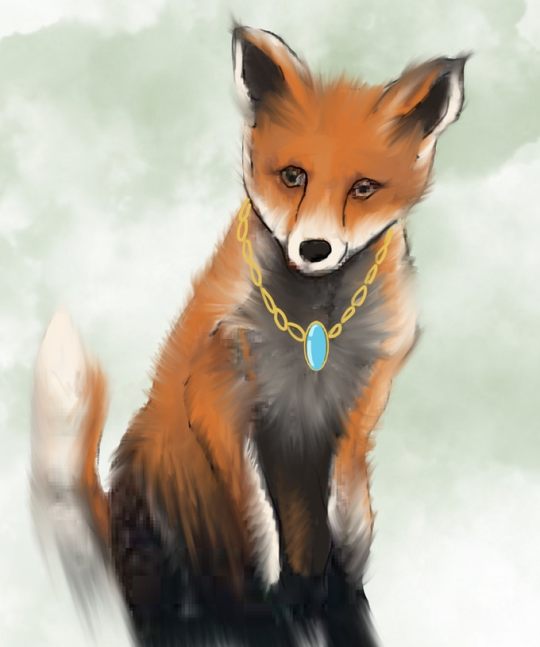
Wellwisher

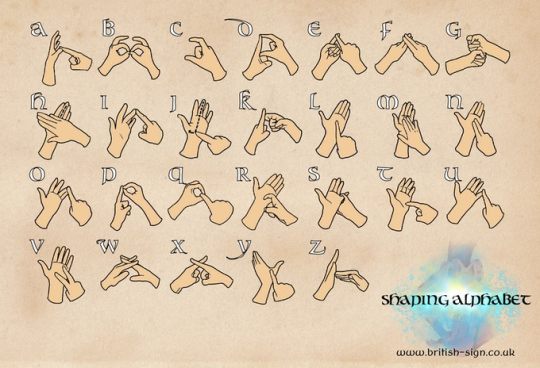
BSL alphabet by british-sign.co.uk
As well as speaking the common tongue for the sake of interactions with humankind, the fey use a form of sign language they believe communicates right to the heart.
The technique is known as Shaping, a term derived from the hand and finger movements used and a deeper meaning of shaping the world around them. Spells are solely expressed through Shaping, with gestures building energy before being released from the fingertips.
Spells are taught only by the Inspired. Only they know the deeper intricacies of the language necessary to harness magic.
Though optional, we are introducing British Sign Language (BSL) and Sign Supported English (SSE) into our game. We are using it as part of the spellcasting process and to solve some of the setting’s most challenging puzzles, encouraging our young players to learn the alphabet and more as they play.
When you back our core book, whether digitally or physically, you will gain access to a video workshop on the art of Shaping produced by our friends in the deaf community. Whilst not a comprehensive introduction to British Sign (see Stretch Goals), it will teach participants enough to encourage them to pursue the language beyond the game.
The core book will also come with an American Sign Language (ASL) alphabet sheet. The video tutorial unlocks through a stretch goal.

Kickstarter campaign ends: Mon, August 17 2020 12:00 AM BST
Website: Hatchlings
62 notes
·
View notes
Note
For the ask thing: N, T, W for tcw :)
ヽ(゜∇゜)ノ
N: Name three things you wish you saw more or in your main fandom.
An appreciation for how massive the GAR really is — even if you subscribe to the ridiculously low-balled canonical size of the army, Fives has no reason to be chummy with everyone, ffs. If Anakin and Obi-Wan weren’t attached at the hip, Rex and Cody would hardly ever lay eyes on each other because there is such a disparity in rank (which should indicate a wildly different brief, but lol, this is TCW, where a marshal commander leads from the trenches and a mere captain has a seat at the strategy table). Obviously, this is just a personal gripe: I don’t actually care how people choose to approach the GAR in their stories, this is all about having fun … *I* just have more fun reading fics that are somewhat grounded in realities.
Mating cycles/heats — idk it just seems to me that this fandom with a plethora of alien species to play with doesn’t explore reproductive diversity and weirdness enough.
Tolerance of clonecest (or whatever the hell you wanna call it, I use that term as shorthand; whether or not clone-on-clone maps onto IRL incest taboos is an essay for another day) — it’s just … it’s interesting to me that folks are more squicked by the possibility that two identical walking war crimes may frot because they have no one else and find some small measure of comfort in each other than, idk, the brutal realities of their lives where death, mutilation, and maiming are omnipresent — and this pervasive idea that clones are the Goodest Bois just out there wearing flower crowns and frying only droids all day makes me : \ This isn’t an exhortation for people to just ‘get over’ their squicks, but I do believe in examining them.
T: Do you have any hard and fast headcanons that you will die defending?
Headcanon: Cody is not a born-again Mando nor does he have any time for whatever watered-down Mandalorian bullshit filtered down from the Spec Ops wing.
Question this headcanon first sought to answer: Why doesn’t Cody wear a kama?
Id-scratching Justification: He loves this thighs.
Plausible Justification: He likes his legs to be unencumbered for roundhouse kicks.
Solid Justification I’ve adopted from kaasknot: He earned his advanced-recon stripes in ARF not ARC school.
My Meta Justification: The line clones do not adopt Mandalorian culture or language wholesale.
I can’t even qualify this with “call me a RepComm snob, but …” because there’s even LESS foundation for the clones-are-vode idea in the new canon. From where would they have imbibed it? Outside the brief nod to Fenn Rau’s pilot instructor days on Kamino, new canon has not given us any reason to believe the line clones had Mandalorian trainers. And even if you discount new canon’s Jango-is-not-a-Mandalorian heresy, Kamino would not be at pains to emphasize their products’ connection to a culture so perennially at odds with their client (the Jedi/Republic).
Upon deployment, really almost anything goes; but to say that clone culture wouldn’t hold up pretty firm in the face of other galactic cultures is a little demeaning, and however much people absorb in their search for identity, why would the clones have immediately glomped onto Mandalorian concepts? Why not Corellian? Or Kuatian? Or Chandrillan? Or hells, even Force traditions? Someone may have pointed out to the odd clone, “hey, y’all were made in the image of a notorious Mandalorian!” and set some wheels turning, and sure, Boil was resourceful enough to do his own homework and decide that he quite liked the precepts of a certain group of Mandalorian paramilitary extremists and wanted to slap their sigil on his helmet, but there’d be such a diversity of osmotic experiences in an army of millions/billions spread out across a galaxy that I simply cannot buy the idea that the clones all woke up one fine day thinking of themselves as Mando or Mando-adjacent.
Setting aside new canon, which I find deathly dull, I prefer RepComm, with its assertion that many of the RCs are born-again Mandos after their sergeants (indeed, the Republic almost has a fifth-columnist problem in Spec Ops with the True Mando influence of the Nulls and certain Alpha ARCs), but the average line trooper view of that mentality is “y'all are a fucking cult.”
The line troops would identify firstly as brothers and soldiers of the Republic, and they would’ve had close to 0 touchpoints with the Prime Clone. In fact, many might resent the connection, especially deeper into deployment (“What has Mandalore ever done for me? They're a bunch of loose cannons — if they aren't refusing to lend a hand, they're actively leading Sep militias for pay. Fuck the lot of them,” etc. etc.). It would have required a shitton of cultural and linguistic leakage from the Spec Ops wing for the bulk of the line troopers to know even more than a handful of words in Mando’a at the time of Geonosis. (I can believe swear words would’ve been adopted hella fast, if only to fill a vacuum.)
But again, the army is not a monolith, and I am fully on board with the idea that some Alpha ARCs made it their mission to teach Vode An to every unit they came across and the sheer epicness made it wildly popular, and that they spread certain words and concepts (vod, shebs, di’kut, Manda, oya, kara, kandosii, etc.) like a rash. Or a company or two got teamed with a Mando sergeant and two squads of RCs for a month and were belting out “Coruscant'a aden mhi” by the end of it. Or a division found itself with an Alpha-ARC XO when their Jedi General's CC got popped two weeks after Geonosis and Alpha-89 wouldn’t rest until every trooper knew Dha Werda Verda by heart and backwards. Just … show me the work — why should I accept that Bly speaks fluent Mando’a in the bedroom? WHY? Invest me in your clone-culture worldbuilding!
ANYWAY, to bring this back round to my die-on-this-hill headcanon about Cody … he doesn’t like kamas or feel compelled to wear one. Setting aside fun Cody-was-an-Alpha-trained-spec-ops-intern-for-a-month-and-hated-it backstories aside, I just don’t think the dude had the time of day for all that the Manda are watching us warrior brethren, hold your buy’ce high vode, one tribe one dream osik. His identity is wrapped up in overseeing the Third Army and serving as General Kenobi’s right-hand man; on balance (if we’re trying to be realistic, see: above), Cody interacts more with natborn officers and Jedi and fellow CCs than your average ground pounder trooper, and Obi-Wan and Republic officers certainly aren’t going to wax lyrical about Mandalore anytime soon. Obviously, Marshal Fucking Commander Cody is well within his rights to read whatever he wants and talk to whomever he wants and adopt whatever beliefs and language he wants. He has all the resources at this fingertips and clearance that would probably make a lot of natborn admins in REPINT weep. But I don’t personally see him going Mando, though it amuses him to watch Rex try :p The minute Cody earnestly starts using Mando’a in a fic, I’m usually out.
W - A trope which you are virtually certain to hate in any fandom.
Hmm. I spent a good hour’s walk thinking about this and came up blank. Hate is a strong word anyway, and if it’s well-written, I can be sold on anything. But, I can almost guarantee I will never click on ABO unless it’s been recc’d or written by a friend. Not because I have any moral objection, just that it doesn’t interest me and good characterization is often lost to the mandatory ABO dynamics.
… on the flip side, I will ALWAYS click on Fuck-or-Die :D
38 notes
·
View notes
Text
Book Review

The Night Circus. By Erin Morgenstern. New York: Doubleday, 2011.
Rating: 4/5 stars
Genre: fantasy
Part of a Series? No
Summary: The circus arrives without warning. No announcements precede it. It is simply there, when yesterday it was not. Within the black-and-white striped canvas tents is an utterly unique experience full of breathtaking amazements. It is called Le Cirque des Rêves, and it is only open at night. But behind the scenes, a fierce competition is underway—a duel between two young magicians, Celia and Marco, who have been trained since childhood expressly for this purpose by their mercurial instructors. Unbeknownst to them, this is a game in which only one can be left standing, and the circus is but the stage for a remarkable battle of imagination and will. Despite themselves, however, Celia and Marco tumble headfirst into love—a deep, magical love that makes the lights flicker and the room grow warm whenever they so much as brush hands. True love or not, the game must play out, and the fates of everyone involved, from the cast of extraordinary circus performers to the patrons, hang in the balance, suspended as precariously as the daring acrobats overhead.
***Full review under the cut.***
Overview: If a book is fairly popular, it’s more likely than not that I’ll end up reading it years after the hype dies down, and this is precisely what happened with The Night Circus. I’ve had a copy on my shelves for years, but I decided to finally pick it up after making my way through a string of non-fiction books. I really enjoyed the atmosphere Morgenstern creates, especially the dreamlike quality that her prose evokes. But while most of the fairy tale elements worked for me, I do wish she had dome more by way of characterization for the two main protagonists and plot. Even so, this book was memorable, and so it earns a 4 star rating from me.
Writing: Morgenstern’s prose has a dreamlike quality to it. The entire novel is written in the present tense, which I usually dislike, but in this case, it felt appropriate; present tense, for me, tends to keep the story at arm’s length, but for something like The Night Circus, that uncanny distance actually enhances the feeling that the circus is not quite real or that it has secrets that we, the readers, are not privy to. In other words, the present tense lends an air of mystery that worked in this story *because* so much of the circus revolved around dazzling, mystifying and tricking patrons into thinking magic isn’t real.
That being said, I do think the periodic interruptions in which Morgenstern describes the experience of the reader going to the circus felt jarring. Every so often, Morgenstern has a section narrated in second person, with phrases like “you make your way to the tent” attempting to immerse the reader in the atmosphere. While these sections were wonderfully written and evoked the senses in pleasing ways, I ultimately felt that they distracted rather than complimented the story.
However, I really did adore Mogenstern’s creativity and imagination. I loved the attractions she envisioned for the circus, as well as its black and white color scheme. Instead of feeling gothic or threatening, the circus felt rather elegant and inviting while still maintaining and air of mystery. In this way, I think Morgenstern struck a nice balance between alluring and unsettling, one that doesn’t drive people away but ignites their curiosity.
Plot: From the summary of the book, it seems as though the majority of the plot will revolve around a “fierce competition” between star-crossed lovers, and while that narrative was present, it often faded into the background for me. The “competition” never seemed to pose a threat or create suspense - there was not really a strong back-and-forth pattern of one-upmanship that challenged the characters to push themselves and their abilities. Instead, the details of the challenge are rather foggy, so even the competitors don’t know the rules or the consequences, and they don’t seem to feel constrained or imprisoned by the competition in any way. I think this could have worked better for me if the whole challenge started competitive but then became forgotten in favor of the two romantic leads outdoing themselves for the sake of making one another happy, and while there was some of that, it didn’t feel like it was much of a guiding thread throughout the book.
I did think that the plot about Bailey and the red headed twins was better constructed, even if some readers found it uninteresting. Even though it was simple (Bailey wanted to get back to the circus and find the girl he had met years ago), Bailey clearly had goals and conflicts that influenced his decisions, from feeling constrained by his family’s expectations to the uncertainty of his future, and I think his arc complemented the main plot nicely - Bailey felt trapped by everyday life, and the circus served as an escape, whereas the circus is a kind of gilded cage for Celia and Marco.
That being said, I do think Morgenstern’s attempt to make the “moral” of her book about the power of stories and storytelling rather ham-fisted. Morgenstern clearly has a love of storytelling herself, and the whole book is an exercise in the power of storytelling, but I don’t think stories had a strong enough presence in the narrative itself to make the whole point of The Night Circus about those topics. Instead, I think the secondary theme of “the future is unwritten” to be much more compelling, and I think the conclusion of the novel should have ended on that note rather than Widget agreeing to tell a story.
Characters: While this book follows a number of characters, the summary primarily focuses on Celia and Marco, two “magicians” of sorts who are thrust into a competition by their mentors in order to prove whose method of doing magic is superior. Celia is more intuitive, performing magic through her “natural abilities,” while Marco is more studious, using things like signs and anchors to guide his magic. Aside from these defining qualities, I didn’t find either of them very memorable. Celia supposedly had the tendency to lose control of her emotions (and magic), but we never really saw that manifest in ways that were threatening to the competition or the people around her. Marco is also somewhat of a blank slate; he’s organized and works hard, but that’s about all I can say about him. I didn’t quite see what qualities attracted the two to each other, much less why they fell in love other than they admired one another’s magic.
Their mentors were a bit more interesting in that the had contrasting personalities. Celia’s mentor (her father), is overbearing and egotistic, whereas Marco’s mentor is reserved. I liked the mystery that surrounded Marco’s mentor and the way his emotions never seemed to get the better of him until certain points. Celia’s father, on the other hand, was a bit annoying and cruel.
I did enjoy reading about the other protagonists, Bailey and the red headed twins (Poppet and Widget). I thought that Bailey had enough external pressure to make his goals and desires feel real. Poppet and Widget also complimented each other nicely; though they are twins, they felt like separate people rather than a duplication of one another, and I liked how they were inquisitive, playful, and caring.
Supporting characters were also incredibly compelling and memorable. Chandresh, the proprietor of the circus, is eccentric, and I loved reading about his house of curiosities and his lavish midnight dinners. Tsukiko, the contortionist, has an appealing attitude that is simultaneously warm and matter-of-fact. Isobel seems like she would serve the role of the jealous lover, but I liked that she was warm and found a home with the circus. Herr Thiessen, the clock maker, encourages others to see the circus with wonder without becoming dangerously obsessed. Other members of the “circus board,” such as Mme. Padva, the Burgess sisters, and Mr. Barris, were also interesting to watch as they left their thumbprints on the circus.
Other: This book didn’t have a lot of worldbuilding (if that’s the appropriate word for it) in that none of the magic systems are fully explained, nor are we told who or what the mentors really are, but I don’t think these things were needed. The lack of full clarity enhanced the sense of mystery about the circus, and in some ways, this book was more “magical realism” than full fantasy.
I do think, however, that the ending to Celia and Marco’s story was rather unfulfilling, in part because it relied on the performance of a kind of magic that I didn’t quite understand. I think it would have been fine if the two had simply disappeared together and their “souls” (or something) still hung around the circus, so readers get the impression that they’re together, but the details aren’t quite clear. The matter of controlling the circus also seemed convoluted, and I’m not convinced that the magic required to do this was seeded into the story ahead of time, so it felt somewhat random. As a result, the ending seems to require us to understand how separate types of magic work, but the details of these systems throughout the book are vague, so the sudden specificity at the end feels strange.
Overall, though, this book was memorable and enchanting, which made up for the shortfalls. I still enjoyed it immensely, and I think Morgenstern is a phenomenal storyteller.
2 notes
·
View notes
Text
Video Game Review: GreedFall (Spiders, 2018)

Genres: action RPG, fantasy
Premise: Players assume the role of De Sardet, a human noble who arrives on the recently-discovered island of Teer Fradee. Able to ally with either the natives who inhabit the land and/or any of the foreign nations competing to colonize it, De Sardet seeks out a cure for the mysterious illness that plagues their family, while also battling monsters and magic.
Platform Played On: PC (Windows)
Rating: 3/5 stars
Disclaimer: My rating is in response to multiple aspects of the game, not just its politics. If I were evaluating solely on politics and gave the developers the benefit of the doubt that they were trying to make something with a good message, my rating would be around the 1 to 2-star range, depending on player choices.
***Full review under the cut.***
I am evaluating this game based on four key aspects: story, characters, gameplay, and visuals.
Story: I’m immediately wary of any pop culture item that tries to tell a story about colonialism and Indigeneity because it usually ends up indulging in colonialist fantasies rather than critiquing them. Complex, morally-grey stories are great and all, but when it comes to tales about colonialism, “both sides” narratives tend to look a little insensitive. So, I can’t tell you why I decided to play GreedFall, other than I heard that it filled the Dragon Age-sized hole in people’s hearts. Since I’d rather use my own judgment than read video game reviews, I bought this game on sale and gave it a go. If nothing else, I told myself, I could use my history and literary analysis chops to say something intelligent about it.
In terms of politics, I don’t think GreedFall was as terrible as games where the goal in itself is colonization, but I also don’t think it achieved a narrative that was critical enough of colonization. De Sardet’s primary goal is to achieve balance between all the nations (which I’m calling factions because they’re mostly that). While I can admire that GreedFall really pushed for peaceful relationships, as well as pushed back against abuse and racism, I ultimately thought the developers didn’t consider how the struggle for balance actually facilitates colonialism. This game presents colonialism a diplomatic issue, so as a result, Teer Fradee is kind of a fantasy where colonists can settle on native land while maintaining friendly relationships with Indigenous peoples (at least, if you play it that way - at worst, you can seize absolute power). The experience was similar to the one I had playing BioShock Infinite, whose politics involve a “both sides” argument - the difference is that BioShock Infinite made explicitly clear by the end of the game that Booker was the true villain. With de Sardet, it’s a bit more ambiguous, depending on how you play, but I do think the game pushes you to be diplomatic rather than power-hungry. As a whole, it brings up the very valid question of whether or not colonialism should be in media period, or if there’s some value to be derived from consuming problematic media that tries to do good and talking about it.
Still, I have to give credit where credit is due. GreedFall had the guts to actually try to tackle little-discussed themes in this game, such as forced conversion, abuse within the sciences, and institutionalized bullying. While the missions associated with these big themes were accomplished with varying degrees of success, many of them added emotional depth to the game. Companions would have emotional reactions to these quests that tugged at my heartstrings, and there were never any shots of graphic violence or mutilated bodies, so it didn’t feel like I was playing the game for an edgy thrill. All of the side quests had a lot of bearing on the main plot and the worldbuilding - I don’t think I encountered any “fetch quests,” so most of the things I was doing actually related to enhancing my understanding of the world and its social dynamics.
The game also did a good job of presenting players with factions that were constantly in conflict with one another, lending an added layer of complexity to all the political aspects of the plot. Character’s personal quests were also very well done and had emotional depth. Vasco’s arc about learning about his true family was a nice exploration of birth family vs found family (he’s a sailor whose birth family gave him to the naval faction, the Nauts). Kurt’s quest was also a good one about the bonds between military recruits and really showed his commitment to people over institutions (he’s de Sardet’s commander at arms). Siora’s quests were more about staying true to her culture (she’s a native and daughter of one of a now-deceased tribe leader), while Aphra’s were about learning to be open minded when learning about a different culture (she’s a scientist interested in plants). Petrus’ were a mix of taking down the head of his Church and helping your character find their roots (he’s something of a pastor who also wields magic to fight). You can tell that the developers were inspired by Bioware games in that you can cultivate reputations with your companions and eventually romance them. Many of these romances are available to both male and female PCs, so there’s potential for a queer ship.
I will say that by the end of game, I was emotionally wrecked, despite all the political problems. So, I do think the developers of this game have a good sense of storytelling - I just wish they had done better politically.
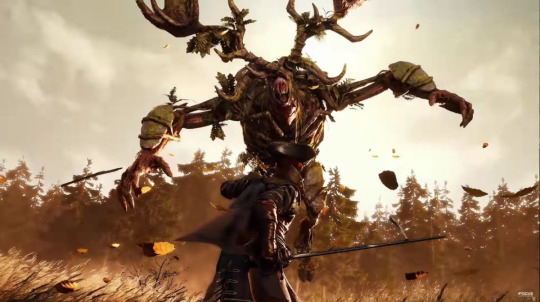
Characters: Similar to Mass Effect or Dragon Age, GreedFall gives players a player-controlled character (PC) and a host of companions to take on an adventuring party. De Sardet, the PC, doesn’t have much personality when they’re being diplomatic, but I did enjoy the moments when they were confronted with information that impacted them emotionally. I played a female de Sardet, and the voice actress did a good job of balancing emotion with the facade that’s required of a diplomat. Constantin, de Sardet’s cousin and governor of New Serene (one of a few colonial settlements on Teer Fradee), is also carefully written as a charismatic, sympathetic nobleman’s son who wants to prove his worth. He and de Sardet share a close bond, which made moral decisions a bit more personal and emotionally difficult. I do think he became a scapegoat for all the evils of colonization, though, and I wish more was done with him to implicate every colonizer on the island. The companions are likewise very likable and fairly unique. Each of them had personal quests and stories that were compelling and sympathetic. I do wish there had been more opportunities to chat with them, or that they talked to each other during exploration (like Bioware companions do). I also appreciated that the Teer Fradee natives weren’t one, homogeneous group. I think too often we see pop culture try to write Indigenous peoples as having the same culture and goals, but with this game, there was some variety regarding what the best course of action would be against an invading force. I’m sure, however, that the depiction of the natives overall was problematic, but I’m not well-versed enough in native representation in pop culture to articulate the issues. While they weren’t portrayed as primitive or child-like (at least, I didn’t think so), I don’t doubt that there were tropes in there that I just couldn’t recognize (for example, Siora maybe a Chief’s Daughter/Indian Princess trope - it’s complicated). I suggest finding and reading an Indigenous critique of the game. (There’s also this one, which is valid, and I do think the game’s efforts and failures are worth talking about.)
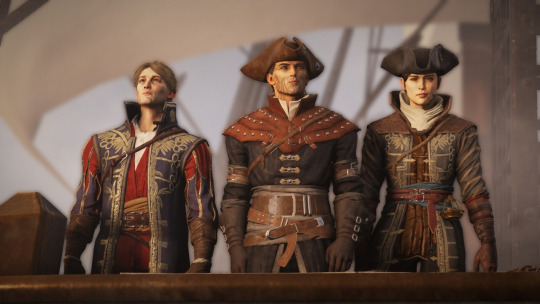
Gameplay: This RPG mainly relies on balancing skills, talents, and attributes. Skills define what weapons you can use and how (one-handed blades, two-handed blades, firearms, magic, etc). Talents are things like charisma, science, or lockpicking - stuff which will affect the way you interact with the world. Attributes are mental and physical abilities like strength or willpower which affect how you wield weapons. Overall, the process of leveling up and gaining points to spend in these areas was pretty straight-forward, and I enjoyed the mental challenge of building a character that fit my play style.
Combat was a little clunky; basic attacks ran just fine for me, but there wasn’t much grace in the way characters dodged or rolled. I also kept getting thrown off by the fact that you can’t press space to jump! But in all, it wasn’t the worst experience. Enemies had helpful health bars, and I enjoyed the combination of a pistol and a rapier to finish off my foes. The diplomatic elements were by far the best part of gameplay for me. If players assign their skill points well, de Sardet can use a number of different tactics and choose from multiple dialogue options, from intimidation to taking advantage of intuition to laying on the charisma. It was fun to figure out which tactic would work on which characters, and how my skill sets translated into consequences for my decisions. I do think, however, that more options could have been presented to players in terms of dialogue choices and role-playing elements. While players make important choices regarding how to handle any given situation, there was little opportunity to purely role play. More opportunities to influence the direction or tone of the dialogue in non-crucial situations, I think, would have helped and made my De Sardet feel more unique.

Visuals: Aesthetically, I very much appreciated that we were given a fantasy game that wasn’t set in the faux Middle Ages. I loved the 18th century vibe to all the clothing and town layouts, and each of the maps were distinct and fully-realized, from the urban settings to the natural ones. There was a bit of repetition in the urban layouts; the palaces, for example, were the same, and some houses were recycled, but it wasn’t nearly as bad as Dragon Age II. I also appreciated that there were people of various races and genders in all positions and all social circles. There were women in the guard, women working on ships, and so on, without any hint that it was unusual. There was also a fairly wide variety of skin tones, with people of color being included in higher social classes and not relegated to lowly servant roles. There are some problems in that “diversity washing” detracts from the racial conflicts that were very present in the 18th century. I don’t think the developers thought through the implications of putting POC in positions of power where they could commit violent colonial acts against the natives. The creatures on the island were interesting to look at. Their designs frequently combined natural imagery (such as vines and wood) with horror to create foes with an eldritch, elemental vibe. The same creepiness was reflected in the fictional disease that afflicts the colonists; the afflicted had black, vine-like tendrils running through the skin, and there was an impending sense of dread whenever I looked at someone who was infected. Despite all the things I liked, GreedFall’s biggest problem is its animation. For a game that was made in 2019, facial expressions and combat are quite clunky, to the point where the characters felt robotic. I understand that not every video game needs to have top-tier level animation, but playing GreedFall was similar to my experiences playing the first Witcher game or the first Mass Effect or Dragon Age: Origins games. Still technically playable, but it feels very outdated.
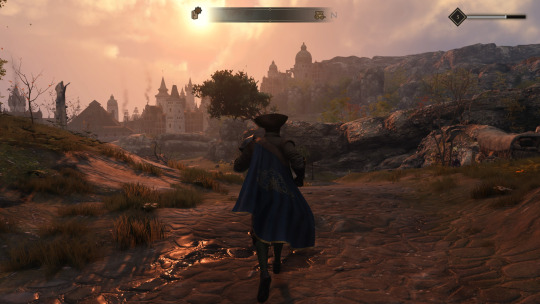
In-Game Triggers: violence (especially racial violence), colonialism, racism, religious zealotry, torture,
I feel the need to point out that while I don’t think this game is gory or explicit in any way (PG-13 would be my rating), there are some scenes that people may find triggering. There’s also one where a Native is killed by a religious zealot, and I found it extremely upsetting (it happens when you first enter San Matheus, if you need a heads up). Other than that, you never actually see characters torture native peoples, but you do hear about it later.
Recommendations: I would recommend this game if you’re interested in the 18th century, the age of imperialism, role-playing games, and fantasy. You might also like this game if you’re a fan of Bioware RPGs.
5 notes
·
View notes